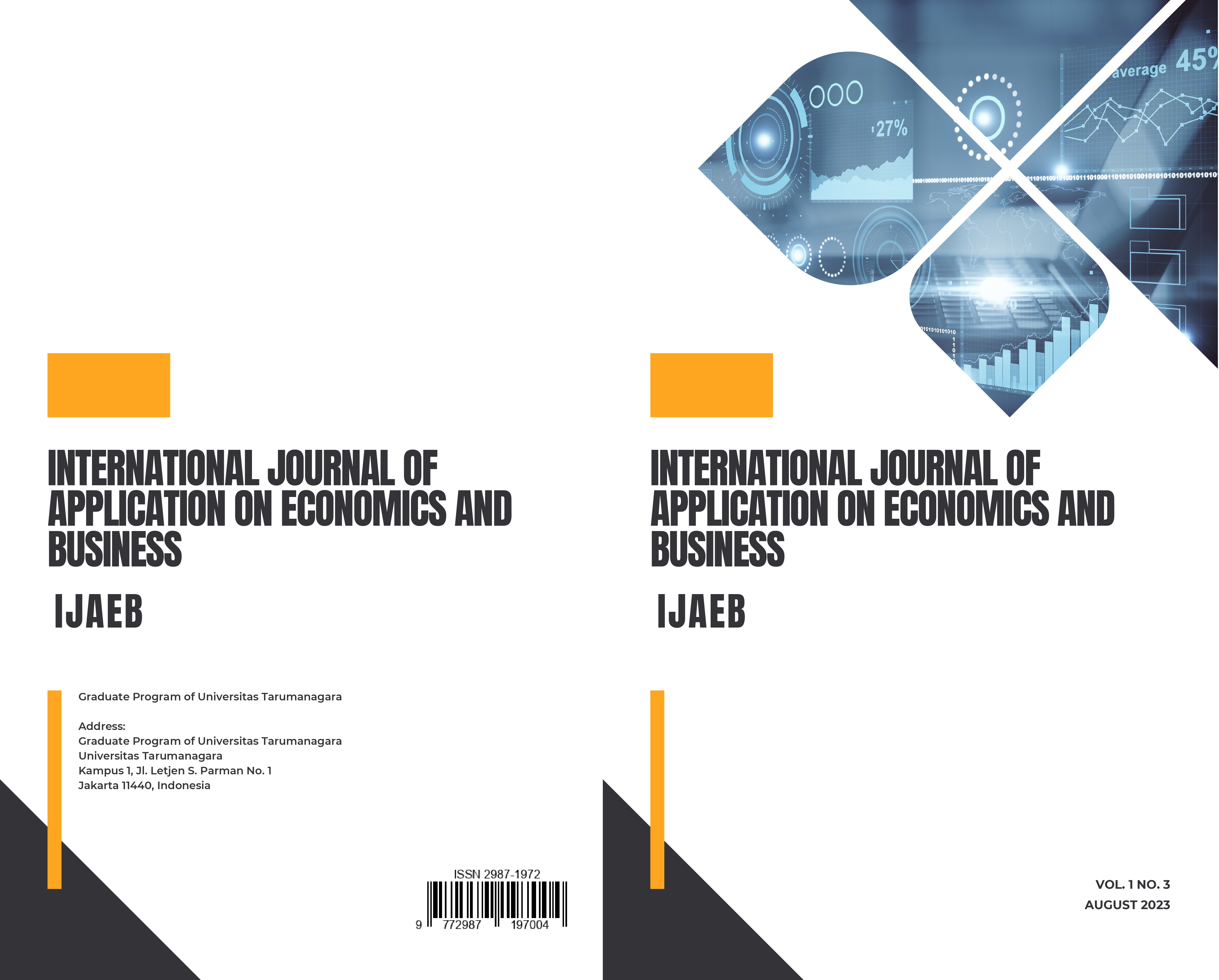DETERMINANTS OF DEBT POLICY IN CONSUMER GOODS COMPANY IN INDONESIA
Main Article Content
Abstract
The intended of this study was to determine the effect of business risk, non-debt tax shields, and firm size on debt policy. The population consists of companies that in the 2019-2021 period are listed on the Stock Exchange in the consumer goods group. Purposive sampling technique was applied to select samples from as many as 74 companies, of which 40 consumer goods companies met the criteria, so that in total there were 120 research data. Data analysis was carried out using Multiple Linear Regression and data processing data is supported by EViews 12. The findings of this research show that changes in company size will move debt policy in a significant and positive direction. Meanwhile, business risk and nonndebt taxxshields have insignificant effect on debttpolicy for companies in the consumerrgoods group registered on the Indonesia StockkExchange.
Article Details

This work is licensed under a Creative Commons Attribution-NonCommercial-ShareAlike 4.0 International License.
This journal provides immediate open access to its content on the principle that making research freely available to the public supports a greater global exchange of knowledge.
IJAEB by Graduate Program of Universitas Tarumanagara is licensed under a Creative Commons Attribution-NonCommercial-ShareAlike 4.0 International License.. Permissions beyond the scope of this license may be available at https://journal.untar.ac.id/index.php/ijaeb
References
A. R. Hakim, Minus Di 2020, Pertumbuhan Industri Manufaktur Melesat Pada 2021, https://www.liputan6.com/bisnis/ekonomi, 2021. https://www.liputan6.com/bisnis/read/ 4843069/minus-di-2020-pertumbuhan-industri-manufaktur-melesat-pada-2021 (accessed Aug. 15, 2022).
E. Endri, B. Mustafa, & O. Rynandi, Determinants of Debt Policy of Real Estate and Property Companies Listed on the Indonesia Stock Exchange, International Journal of Economics and Financial Issues, vol. 9, no. 2, pp. 96–104, 2019, [Online]. Available: http:www.econjournals.comDOI:https://doi.org/10.32479/ijefi.7618.
B. A. Abdulmumin, Determinants of Debt Financing in Nigeria, EuroEconomica - BUSINESS ADMINISTRATION AND BUSINESS ECONOMICS, vol. 3, no. 39, pp. 141–149, 2020.
W. Arfina, Pengaruh Tangibility, Profitabilitas, Growth, Risiko Bisnis Dan Likuiditas Terhadap Kebijakan Hutang Pada Perusahaan Manufaktur Sektor Industri Kimia Dan Dasar Yang Terdaftar Di BEI Periode 2011-2015., JOM Fekon, vol. 4, no. 2, pp. 3400-3414., 2017.
H. Viriya & R. Suryaningsih, Determinant of Debt Policy: Empirical Evidence from Indonesia, GATR Journal of Finance and Banking Review, vol. 2, no. 1, pp. 01–08, 2017, doi: 10.35609/jfbr.2017.2.1(1).
S. SORAYA & M. PERMANASARI, Faktor-Faktor Yang Mempengaruhi Kebijakan Hutang Perusahaan Non Keuangan Publik, Jurnal Bisnis dan Akuntansi, vol. 19, no. 1, pp. 103–116, 2017, doi: 10.34208/jba.v19i1.69.
W. L. Lin, N. Yip, M. Sambasivan, & J. A. Ho, Corporate Debt Policy of Malaysian SMEs: Empirical Evidence from Firm Dynamic Panel Data, International Journal of Economics and Management, vol. 12, no. Special Issue 2, pp. 491–508, 2018.
B. I. Ehikioya, An Empirical Analysis of the Determinants of Corporate Debt Policy of Nigerian Firms, International Journal of Economics and Financial Research ISSN, vol. 4, no. 6, pp. 180–187, 2018.
M. Ulum & M. H. Mustafa, The Effect of Profitability , Free Cash Flow , Company Growth and Company Size on Debt Policy of Food and Beverage Subsectors Registered in Indonesia Stock Exchange Period 2013-2017, International Journal of Innovative Science and Research Technology, vol. 4, no. 12, pp. 1141–1152, 2019.
E. F. Brigham & P. R. Daves, Intermediate Financial Management, 13th Edition, vol. 21, no. 3. Boston, MA 02210 USA: Cengage Learning, Inc, 2019.
A. Sulistiani & L. Agustina, Determinants of Debt Policy with Profitability as a Moderating Variable, Accounting Analysis Journal, vol. 8, no. 3, pp. 184–190, 2019, doi: 10.15294/aaj.v8i3.35181.
E. F.Brigham & Michael C. Ehrhardt, Financial Management, Theory and Practice, 15th ed. Boston, MA 02210: Cengage Learning, 2017.
A. Syakhroza & Endri, Hubungan Kausalitas Harga Saham Dan Nilai Tukar Di Negara-Negara Asean-5, FInance and Banking Journal, vol. 14, no. 2, pp. 17–31, 2012.
H. Mukhibad, S. Subowo, D. O. Maharin, & S. Mukhtar, Determinants of Debt Policy for Public Companies in Indonesia, Journal of Asian Finance, Economics and Business, vol. 7, no. 6, pp. 29–37, 2020, doi: 10.13106/JAFEB.2020.VOL7.NO6.029.
A. Veronica, Kebijakan Hutang Pada Perusahaan Manufaktur Yang Terdaftar Di Bursa Efek Indonesia, Jurnal Media Wahana Ekonomika, vol. 17, no. 1, p. 1, 2020, doi: 10.31851/jmwe.v17i1.4333.
R. Nurdani & I. Y. Rahmawati, The Effect of Firm Sizes, Profitability, Dividend Policy, Asset Structure, Sales Growth and Free Cash Flow on Debt Policy, AMAR (Andalas Management Review), vol. 4, no. 1, pp. 100–119, 2020, doi: 10.25077/amar.4.1.100-119.2020.
N. M. Nugraha, A. A. Hakim, B. T. Fitria, & N. Hardiyanto, The Influence Company Size, Asset Structure, Company Growth, Profitability on Debt Policy, ECONOMICA Jurnal Program Studi Pendidikan Ekonomi, vol. 9, no. 1, 2020.
A. T. Basuki & N. Prawoto, Analisis Regresi dalam Penelitian Ekonomi dan Bisnis. Rajawali Pers, 2016.



